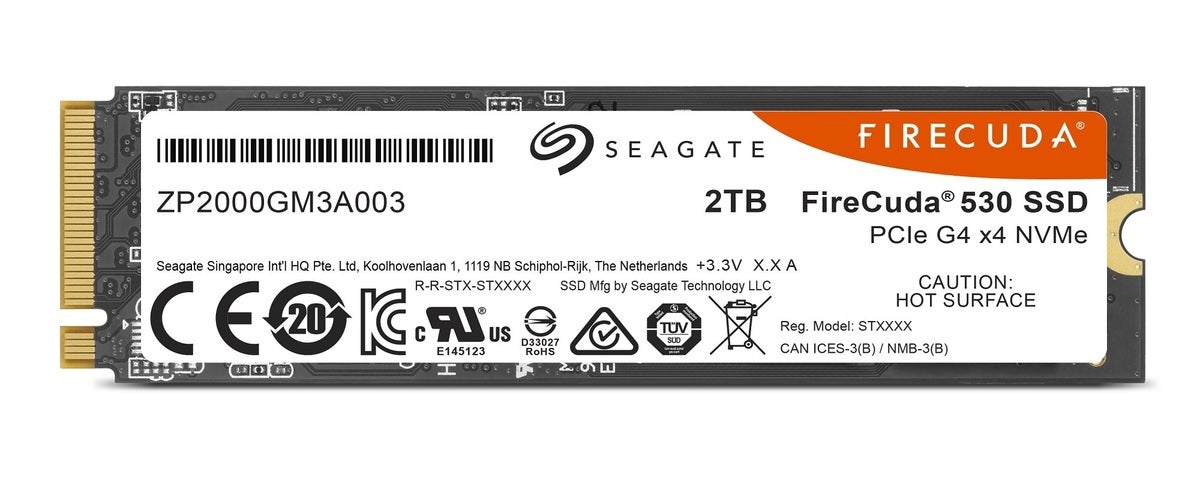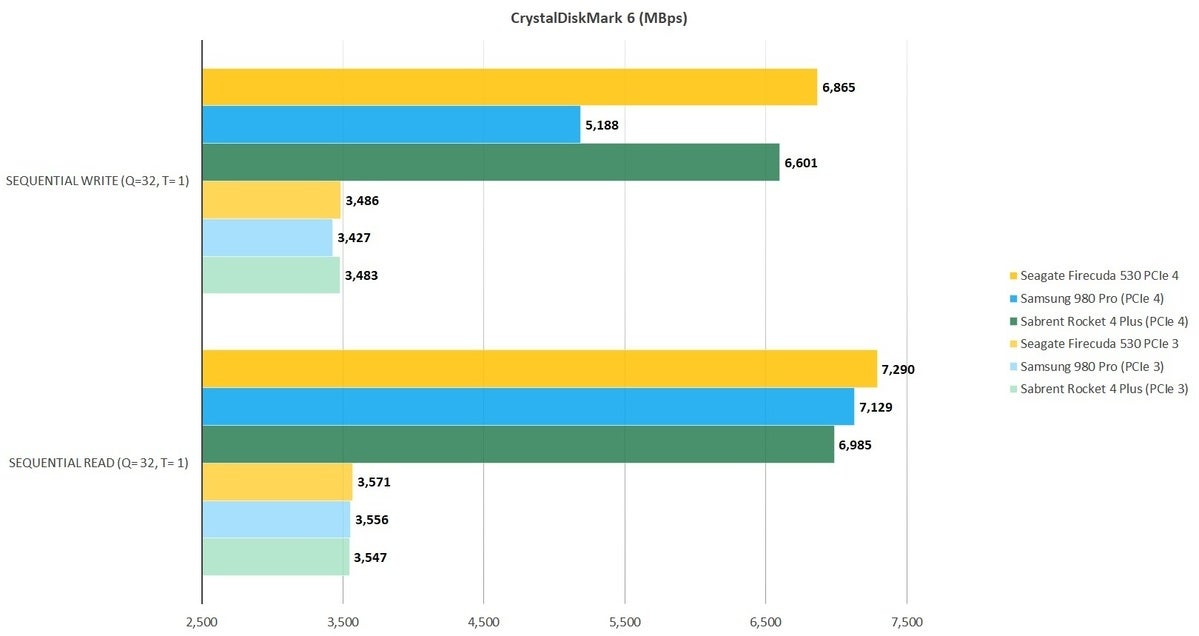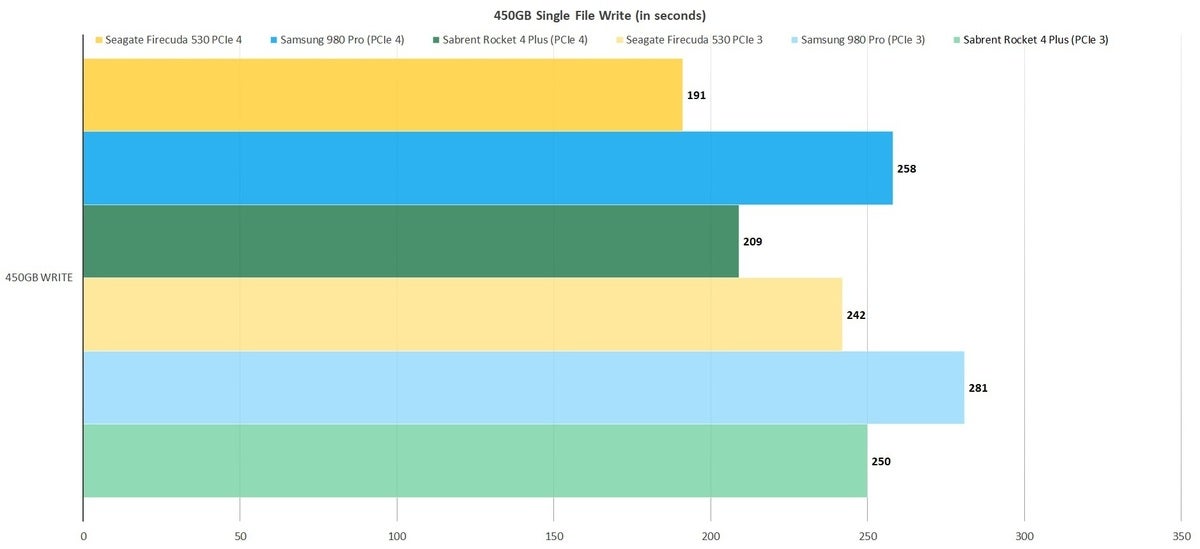 At a Glance
At a GlanceExpert's Rating
Pros
- Fastest NVMe PCIe 4 SSD we’ve tested to date
- Very high TBW (longevity) rating
- Five-year warranty with three-year data recovery for free
Cons
- On the pricey side
Our Verdict
The Seagate FireCuda 530 (2TB) is the fastest NVMe SSD we’ve tested; it has a very high TBW rating for a consumer drive; and it also carries a five-year guarantee with three years of data recovery coverage. It isn’t cheap, but it’s the best thing out there.
Best Prices Today: Seagate FireCuda 530 (2TB)
The Seagate FireCuda 530 is currently the fastest NVMe SSD on the market. It not only bested the best of the rest in our real-world and synthetic benchmarks, it did so by a healthy margin in several tests. If you can afford it and you can find it, you won’t regret it.
This review is part of our ongoing roundup of the best SSDs. Go there for information on competing products and how we tested them.
Design and specs
The FireCuda 530 is a 2280 (22mm wide, 80mm long), PCIe 4 x4, NVMe SSD. Seagate, like many other vendors these days, are loath to reveal the fine details of their SSDs, so we’ve taken to stripping off the labels and reading the chip numbers. The 2TB model I tested has 2GB of SK Hynix DDR4 primary cache. It uses a Phison PS6108 controller, and it stores bits on 176-layer 3D Micron TLC (Triple-Level Cell/3-bit) NAND. Good stuff.

Alas, an SSD as fast as the FireCuda 530 is going to be expensive, but the bigger problem at the time of this review was availability: It was sold out in all capacities at all major online retailers, including Best BuyRemove non-product link and Amazon. A Seagate representative said the company expected the drives to resurface later in August. Based on the prices shown on Newegg.com you’ll pay $160 for 500GBRemove non-product link, $260 for 1TBRemove non-product link; $540 for the 2TBRemove non-product link capacity we tested, and a cool $1,000 for 4TBRemove non-product link. Newegg’s product pages estimate availability by August 30.
For some reason, the models with a preinstalled heat sink carry a rather large upcharge. Standalong heatsings average $15.
The 2TB and 4TB drives are double-sided, while the 512GB/1TB capacities are single-sided. This is a possible consideration if your laptop is super-thin.
Seagate has great faith in the Firecuda 530’s longevity, possibly because the 176-layer NAND might allow greater over-provisioning, or is simply more robust. The drives are warrantied for five years and rated for 640TBW (512GB model), 1,275TBW (1TB), 2,550TBW (2TB), and 5,100TBW (4TB), respectively. TBW stands for TeraBytes Written, i.e. the number of bytes that may be written before the drive wears out. Ratings over one TB written per GB of capacity, as they are here, are very generous.
To top off its act of certitude, Seagate will recover data from a failed FireCuda 530 for the first three years of ownership, free of charge. Let’s hope that’s something you never have to utilize. Seagate’s probably counting on that. I kid. Mostly.
Performance
There’s no suspense in this performance section, as the article title and opening paragraph openly tout the FireCuda 530’s performance. That said, we were a bit surprised by the the margin of victory. The 2TB model beat the former champ, the Samsung 980 Pro, in every test save one, and trounced it by a hefty margin in several. That’s got to make Phison and Seagate pretty happy—Samsung hasn’t been knocked off it’s best-of-breed perch very often.

Read ‘em and weep, rival vendors. The Firecuda 530 is the fastest drive we’ve tested in both synthetic benchmarks and real-world transfers.
The FireCuda 530 was the first SSD to write our 450GB test file in less than 200 seconds. And according to AS SSD 2 (not shown), it also had extremely low read access times of 0.016 milliseconds. The random access write time from that benchmark was actually high, at 0.16 ms, but that never reared its head in the real-world tests.

In short, the FireCuda 530 is the fastest NVMe x4 PCIe 4 SSD you can buy. Note that the 500GB version is a significantly slower writer than the others, especially over PCIe 4. Seagate provides estimated performance numbers in the FireCuda 530’s data sheet.
I do need to issue our new standard warning: Seagate is a dependable company, but the recent chip shortages and other factors have had some SSD vendor swapping parts–in rare cases, such as with Adata, to negative effect.
The PCIe 3 tests utilized Windows 10 64-bit running on a Core i7-5820K/Asus X99 Deluxe system with four 16GB Kingston 2666MHz DDR4 modules, a Zotac (NVidia) GT 710 1GB x2 PCIe graphics card, and an Asmedia ASM3242 USB 3.2×2 card. It also contains a Gigabyte GC-Alpine Thunderbolt 3 card, and Softperfect Ramdisk 3.4.6 for the 48GB read and write tests.
The PCIe 4 testing was done on an MSI MEG X570 motherboard socketing an AMD Ryzen 7 3700X 8-core CPU, using the same Kingston DRAM, cards, and software. All testing is performed on an empty, or nearly empty drive. Performance will decrease as the drive fills up.
You want the fastest? This is it
The Seagate FireCuda 530 is the fastest PCIe 4 NVMe SSD we’ve seen to date. It’s a bit pricey, but the extra cash also delivers outstanding longevity and support. Highly recommended.
This article was edited on August 18th, 2021 to correct the label in the CDM 6 results from FireCuda 520 to FireCuda 530. And again on October 10th, 2022 to amend a typo.


